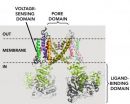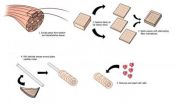Staphylococcus aureus: Why it just gets up your nose!
Nasal colonization by Staphylococcus aureus depends upon clumping factor B binding to the squamous epithelial cell envelope protein loricrin
2012-12-28
(Press-News.org) A collaboration between researchers at the School of Biochemistry and Immunology and the Department of Microbiology at Trinity College Dublin has identified a mechanism by which the bacterium Staphylococcus aureus (S. aureus) colonizes our nasal passages. The study, published today in the Open Access journal PLOS Pathogens, shows for the first time that a protein located on the bacterial surface called clumping factor B (ClfB) has high affinity for the skin protein loricrin.
S. aureus is a major human pathogen, with the potential to cause severe invasive diseases. It is a major cause for concern in hospitals and healthcare facilities, where many infections are caused by strains resistant to commonly used antibiotics [MRSA]. Interestingly, S. aureus persistently colonizes about 20% of the human population by binding to skin-like cells within the nasal cavity. Being colonized predisposes an individual towards becoming infected so it is vital that we understand the mechanisms involved.
ClfB was previously shown to promote S. aureus colonization in a human nasal colonization volunteer study. This paper now identifies the mechanism by which ClfB facilitates S. aureus nasal colonization. Purified ClfB bound loricrin with high affinity and this interaction was shown to be crucial for successful colonization of the nose in a mouse model. A knockout mouse lacking loricrin in its skin cells allowed fewer bacterial cells to colonize its nasal passages than a normal mouse. When S. aureus strains that lacked ClfB were used nasal colonization could not be achieved at all. Finally it was shown that soluble loricrin could reduce binding of S. aureus to human nasal skin cells and that nasal administration of loricrin reduced S. aureus colonization of mice.
Rachel McLoughlin, the study's corresponding author and Lecturer at the School of Biochemistry and Immunology at Trinity College Dublin concludes, "Loricrin is a major determinant of S. aureus nasal colonization." This discovery therefore opens new avenues for developing therapeutic strategies to reduce the burden of nasal carriage and consequently infections with this bacterium. This is particularly important given the difficulties associated with treating MRSA infections.
###
FINANCIAL DISCLOSURE: This project was funded by a Science Foundation Ireland Programme Investigator award 08/IN.1/B1845 to TJF and a Wellcome Trust RCDF (WT086515MA) to RMM. The funders had no role in the study design, data collection and analysis, decision to publish, or preparation of the manuscript.
COMPETING INTERESTS: The authors have declared that no competing interests exist.
CITATION: Mulcahy ME, Geoghegan JA, Monk IR, O'Keeffe KM, Walsh EJ, et al. (2012) Nasal Colonisation by Staphylococcus aureus Depends upon Clumping Factor B Binding to the Squamous Epithelial Cell Envelope Protein Loricrin. PLOS Pathog 8(12): e1003092. doi:10.1371/journal.ppat.1003092
CONTACT:
Gina Alvino
plospathogens@plos.org
PLEASE MENTION THE OPEN-ACCESS JOURNAL PLOS Pathogens AS THE SOURCE FOR THIS ARTICLE AND PROVIDE A LINK TO THE FREELY AVAILABLE TEXT. THANK YOU.
PLOS Pathogens is an open-access, peer-reviewed journal published weekly by the Public Library of Science (PLOS).
Disclaimer
This press release refers to an upcoming article in PLOS Pathogens. The release is provided by the article authors. Any opinions expressed in these releases or articles are the personal views of the journal staff and/or article contributors, and do not necessarily represent the views or policies of PLOS. PLOS expressly disclaims any and all warranties and liability in connection with the information found in the releases and articles and your use of such information.
Media Permissions
PLOS Journals publish under a Creative Commons Attribution License, which permits free reuse of all materials published with the article, so long as the work is cited (e.g., Kaltenbach LS et al. (2007) Huntingtin Interacting Proteins Are Genetic Modifiers of Neurodegeneration. PLOS Genet 3(5): e82. doi:10.1371/journal.pgen.0030082). No prior permission is required from the authors or publisher. For queries about the license, please contact the relative journal contact indicated here: http://www.plos.org/about/media-inquiries/.
About PLOS Pathogens
PLOS Pathogens publishes outstanding original articles that significantly advance the understanding of pathogens and how they interact with their host organisms. All works published in PLOS Pathogens are open access. Everything is immediately available subject only to the condition that the original authorship and source are properly attributed. Copyright is retained by the authors. The Public Library of Science uses the Creative Commons Attribution License.
About the Public Library of Science
The Public Library of Science (PLOS) is a non-profit organization of scientists and physicians committed to making the world's scientific and medical literature a freely available public resource. For more information, visit http://www.plos.org. END
ELSE PRESS RELEASES FROM THIS DATE:
2012-12-28
December 27, 2012, Shenzhen, China - A Chinese research team, led by Beijing Forestry University, BGI, Beijing Lin Fu Ke Yuan Flowers Co., Ltd, and other institutes, has completed the first genomic sequence of Prunus mume, known as mei. This work is extremely important for the deeper understanding of Rosaceae evolution and provides an invaluable resource for the improvement of fruit trees. The latest study was published online today in Nature Communication.
As one of the longest-lived flowering fruit trees, the P. mume was domesticated in China more than 3,000 years ago. ...
2012-12-28
BEER-SHEVA, Israel, December 27, 2012 -- Ben-Gurion University of the Negev's (BGU) Social Networks Security Research Group in its Department of Information Systems Engineering has developed a novel method to predict how well or badly a student will perform in an academic course.
The information can be used to determine which students need the most help, as well as which ones excel and might be guided to further study or careers in that subject area. The paper, "Predicting Student Exam Scores by Analyzing Social Network Data," was presented earlier this month at the Advanced ...
2012-12-28
Two studies in The Journal of General Physiology (JGP) help pave the way for a "shortcut" model-free approach to studying activation of "polymodal" ion channels—channels that open in response to multiple stimuli. Transmembrane ion channels respond to various physiological stimuli to regulate numerous cellular functions. Different classes of channels respond to different types of stimuli; some channels, for instance, respond to changes in membrane potential whereas others are activated by ligand binding. Polymodal channels integrate different cellular signals, enabling them ...
2012-12-28
MEDFORD/SOMERVILLE, Mass. (December, 26 2012) – Tufts University School of Engineering researchers have developed a novel method for fabricating collagen structures that maintains the collagen's natural strength and fiber structure, making it useful for a number of biomedical applications.
Collagen, the most abundant protein in the body, is widely used to build scaffolds for tissue engineering because it is biocompatible and biodegradable. Collagen is, however, hard to work with in its natural form because it is largely insoluble in water, and common processing techniques ...
2012-12-28
Boulder, Colo., USA – GSA BULLETIN articles posted online between 10 Dec. and 21 Dec. 2012 include a new version of The Geological Society of America's Geologic Time Scale. This paper marks the beginning of a special series of invited papers in celebration of GSA's 125th Anniversary in 2013. Highlights are provided below.
1. A new/revised GSA geologic time scale.
2. Complex mammal fossil record of the Gran Barranca, Patagonia, Argentina.
3. A new and simple method for estimating the rate of sediment delivery to ancient basins.
4. A study of the provenance of volcanic ...
2012-12-28
Research using new technology shows that our ability to imitate facial expressions depends on learning that occurs through visual feedback.
Studies of the chameleon effect confirm what salespeople, tricksters, and Lotharios have long known: Imitating another person's postures and expressions is an important social lubricant.
But how do we learn to imitate with any accuracy when we can't see our own facial expressions and we can't feel the facial expressions of others?
Richard Cook of City University London, Alan Johnston of University College London, and Cecilia Heyes ...
2012-12-28
One approach to understanding components in living organisms is to attempt to create them artificially, using principles of chemistry, engineering and genetics. A suite of powerful techniques—collectively referred to as synthetic biology—have been used to produce self-replicating molecules, artificial pathways in living systems and organisms bearing synthetic genomes.
In a new twist, John Chaput, a researcher at Arizona State University's Biodesign Institute and colleagues at the Department of Pharmacology, Midwestern University, Glendale, AZ have fabricated an artificial ...
2012-12-28
PHILADELPHIA - Calpain, a calcium-regulated enzyme, is essential to a host of cellular processes, but can cause severe problems in its overactivated state. It has been implicated as a factor in muscular dystrophy, AIDS, Alzheimer's disease, multiple sclerosis, and cancer. As such, finding and exploiting calpain inhibitors is an important area of research.
A team from the Perelman School of Medicine, University of Pennsylvania, in collaboration with the University of California at San Francisco and the Department of Biochemistry and Protein Function Discovery at Queen's ...
2012-12-28
Nashville (Tenn.) - The decision by several states not to expand Medicaid health insurance for the poor may create unintended cuts for hospitals that provide uncompensated care, according to a study by John Graves, Ph.D., a Vanderbilt policy expert in the Department of Preventive Medicine.
Graves used financial data from U.S. hospitals and insurance data in each state to predict cuts in Medicare and Medicaid disproportionate share (DSH) funds paid to the nearly three-fourths of U.S. hospitals that serve low-income patients. The results, published in the Dec. 20 issue ...
2012-12-28
PHILADELPHIA - One of the world's most devastating diseases is malaria, responsible for at least a million deaths annually, despite global efforts to combat it. Researchers from the Perelman School of Medicine at the University of Pennsylvania, working with collaborators from Drexel University, The Children's Hospital of Philadelphia, and Johns Hopkins University, have identified a protein in human blood platelets that points to a powerful new weapon against the disease. Their work was published in this months' issue of Cell Host and Microbe.
Malaria is caused by parasitic ...
LAST 30 PRESS RELEASES:
[Press-News.org] Staphylococcus aureus: Why it just gets up your nose!
Nasal colonization by Staphylococcus aureus depends upon clumping factor B binding to the squamous epithelial cell envelope protein loricrin




